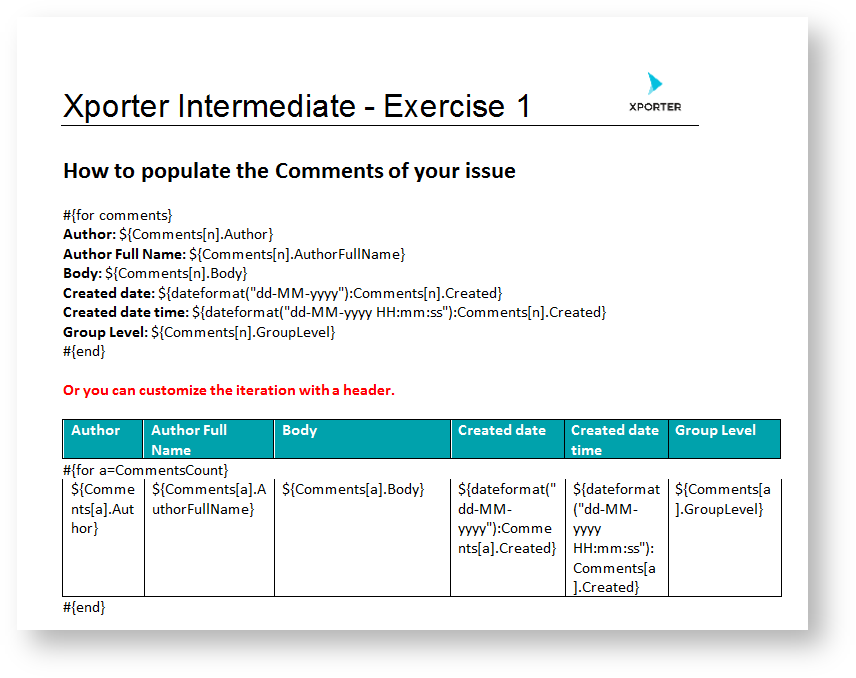The main goal of this exercise is to give you an idea about how Xporter works with iterations.
You'll learn how to populate the Issue Comments on an Xporter-generated file. The mappings in use are documented here.
The section between #{for comments} and #{end} will grow dynamically according to the number of existing Comments on the Issue. In order to start iterating over Issue Comments, put the mapping #{for comments} at the beginning of the iteration section of your template, and at the end, put the mapping #{end} to close it.
Since you're iterating, put Comments[n]. at the beginning of the mapping of the Comment Field you're trying to populate.
When using the #{for comments} statement, the variable name will always be n. If you want to use a different variable name, like a, you must start your iteration instead with the statement #{for a=CommentsCount} and must make sure to change it properly on the Comments[a]. at the beginning of the mapping of the Comment Field you're trying to populate.
#{for comments}
${Comments[n].Author}
${Comments[n].AuthorFullName}
${Comments[n].Body}
${Comments[n].Created}
${Comments[n].GroupLevel}
#{end}
#{for <VariableName>=CommentsCount}
${Comments[VariableName].Author}
${Comments[VariableName].AuthorFullName}
${Comments[VariableName].Body}
${Comments[VariableName].Created}
${Comments[VariableName].GroupLevel}
#{end}
If you want to display your Comments Iteration as a Table with a Header, first create the Header using a table with 6 columns and 1 row:
| Author | Author Full Name | Body | Created date | Created date time | Group Level |
|---|
Below it, put the #{for comments} or #{for <VariableName>=CommentsCount} statement, so the Header is printed only once.
Then, create another table where the Issue Comments will be populated:
| ${Comments[n].Author} | ${Comments[n].AuthorFullName} | ${Comments[n].Body} | ${dateformat("dd-MM-yyyy"):Comments[n].Created} | ${dateformat("dd-MM-yyyy HH:mm:ss"):Comments[n].Created} | ${Comments[n].GroupLevel} |
Finally, close the statement using the mapping #{end}.
You can do this on other types of Iterations. For more details, please refer to the documentation here.
Below is a sample of how the mappings will be displayed in a Word template:
This Template has:
- a header with an image
- Headings
- Text styling
- Table
Below is a sample of how the generated file will be populated:
If you like this exercise, please leave a comment or a . Your feedback is very important to us.
Thank you in advance.
Enjoy our product.

